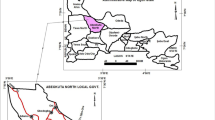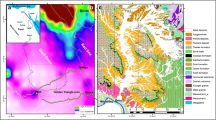Abstract
Groundwater studies often involve using any one of geophysical, geological, geochemical, or chemical data in the assessment of its characteristics. An integrated method in using all the above had been carried out for more comprehensive and confirmative assessments along the Thandava River basin, India. The geophysical data included the recording of the vertical electrical soundings by Schlumberger array configuration in 50 stations along the basin. Thirty soil samples and rainfall data of 5 years included the geological data. Chemical characterizations for 117 groundwater water samples were carried for two seasons. This study proposes the advantages besides delineating the approach in carrying integrated rather than mere single parameter-based speculative study. This correlative and computer modeling aided study led to an in-depth along with confirmative assessments on various geological, geophysical, and chemical characteristics of the groundwater along with the pollution status. Comprehensive details of groundwater like geomorphology, potential water zones, flow pattern, soil types, geochemical evolution of ions, chemical status, and suitability can be accessed by applying this type of integrated study.

ᅟ





Similar content being viewed by others
References
Andrew, R., & Pedro, M, S. (2005). The challenge of collaborative groundwater governance: four case studies from Spain and Australia. [http://www.newater.uni-osnabrueck.de/caiwa/data/papers%20session/F4/ARPMSCAIWA.pdf]
APHA, AWWA, & WPCF. (1995). Standard methods for the examination of water and waste water (19th ed., pp. I–47). Washington DC: APHA.
Arias-Estévez, M., López-Periago, E., Martínez-Carballo, E., Simal-Gándara, J., Mejuto, J. C., & García-Río, L. (2008). The mobility and degradation of pesticides in soils and the pollution of groundwater resources. Agriculture, Ecosystems & Environment, 123(4), 247–260.
Atekwana, E. A., Atekwana, E. A., Rowe, R. S., Werkema, D. D., & Legall, F. D. (2004). The relationship of total dissolved solids measurements to bulk electrical conductivity in an aquifer contaminated with hydrocarbon. Journal of Applied Geophysics, 56(4), 281–294.
Bose, R. N., Chatterjee, D., & Sen, A. K. (1973). Electrical resistivity surveys for groundwater in the Aurangabad sub-division, Gaya district, Bihar, India. Geoexploration, 11(1), 171–181.
Chandra, S., Rao, V. A., Krishnamurthy, N. S., Dutta, S., & Ahmad, S. (2006). Integrated studies for characterization of lineaments used to locate ground water potential zones in hard rock region of Karnataka, India. Hydrogeology, 14, 1042–1051.
Chebotarev, I. I. (1955). Metamorphism of natural waters in the crust of weathering. Geochemica. Cosmochim. Acta, 8, 198–212.
Chen, J., Taniguchi, M., Liu, G., Miyaoka, K., Onodera, S. I., Tokunaga, T., & Fukushima, Y. (2007). Nitrate pollution of groundwater in the Yellow River delta, China. Hydrogeology Journal, 15(8), 1605–1614.
Das, B. K., & Dhiman, S. C. (2003). Water and sediment chemistry of higher Himalayan lakes in the Spiti Valley: control on weathering, provenance and tectonic setting of the basin. Environmental Geology, 44(6), 717–730.
Das, B. K., & Kaur, P. (2007). Geochemistry of surface and subsurface waters of Rewalsar Lake, Mandi district: Himachal Pradesh: constraints on weathering and erosion. Journal of Geological Society of India, 58, 1020–1030.
Datta, P. S., & Tyagi, S. K. (1996). Major ion chemistry of groundwater in Delhi area: chemical weathering processes and groundwater flow regime. Journal of the Geological Society of India, 47, 179–188.
Dowling, C. B., Poreda, R. J., & Basu, A. R. (2003). The groundwater geochemistry of the Bengal Basin: weathering, chemsorption, and trace metal flux to the oceans. Geochimica et Cosmochimica Acta, 67(12), 2117–2136.
Elias, D., & Ierotheos, Z. (2006). Groundwater vulnerability and risk mapping in a geologically complex area by using stable isotopes, remote sensing and GIS techniques. Envi. Geology, 51, 309–323.
Emenike, E. A. (2001). Geophysical exploration for groundwater in the sedimentary environment: a case study. Global Journal of Pure and Applied Sciences, 7(1), 97–102.
Fitterman, D. V., & Stewart, M. T. (1986). Transient electromagnetic sounding for groundwater. Geophysics, 51(4), 995–1005.
Frohlich, R. K., & Urish, D. W. (2002). The use of geoelectrics and test wells for the assessment of groundwater quality of a coastal industrial site. Journal of Applied Geophysics, 50(3), 261–278. ftp://ftp.conservation.ca.gov/pub/oil/SB4DEIR/docs/GW_Todd_and_Mays_2005.pdf.
Golterman, H. L., Glymo, R. S., & Ohnstad, M. A. M. (1978). Methods for physical and chemical analysis of freshwater. IBP hand book. USA: Blackwell Scientific Publication.
I.S.I. (Indian Standards Institution), (1983). Indian Standard Specification for drinking water, 15: 10500.
Jeong, C. H. (2001). Effect of land use and urbanization on hydrochemistry and contamination of groundwater from Taejon area, Korea. Journal of Hydrology, 253(1), 194–210.
Jury, W. A., Focht, D. D., & Farmer, W. J. (1987). Evaluation of pesticide groundwater pollution potential from standard indices of soil-chemical adsorption and biodegradation. Journal of Environmental Quality, 16(4), 422–428.
Karlen, D. L., Mausbach, M. J., Doran, J. W., Cline, R. G., Harris, R. F., & Schuman, G. E. (1997). Soil quality: a concept, definition, and framework for evaluation (a guest editorial). Soil Science Society of America Journal, 61(1), 4–10.
Kshirasagar, T. V. S. R., & Nagamalleswara Rao, B. (1989). Electrical resistivity survey for groundwater in Varaha River basin, AP, India. In: International workshop on appropriate methodologies for development and management of groundwater resources in developing countries (pp. 329–332).
Kumar, K. K. (2011). Geomorphological impact assessment on groundwater quality and fluoride genesis along the Bay of Bengal of Visakhapatnam district, Andhra Pradesh, India. Clean: Soil, Air, Water, 39(10), 925–930.
Kumar, K. K., Israel, Y., & Sowjanya, P. (2013). Geochemical assessment of groundwater along Thandava River basin, Andhra Pradesh, India. Nature, Environment and Pollution Technology, 12(4), 709–716.
Lewis Brent, R. (2001). Applications of electrical resistivity: a surface geophysical method- resource notes. Soils/Geology, 62, 1–2.
Milovanovic, M. (2007). Water quality assessment and determination of pollution sources along the Axios/Vardar River, Southeastern Europe. Desalination, 213(1), 159–173.
Muhammed, A., Cheema, J. M., & Shafique, A. (2007). Determination of lithology and groundwater quality by electrical resistivity survey. International Journal of Agricultural and Biology, 9(1), 143–146.
Murthy, K. S. R., Amminedu, E., & Rao, V. V. (2003). Integration of thematic maps through GIS for identification of groundwater potential zones. Journal of the Indian Society of Remote Sensing, 31(3), 197–210.
Ophori, D. U., & Toth, J. (1989). Patterns of ground‐water chemistry, Ross Creek Basin, Alberta, Canada. Ground Water, 27(1), 20–26.
Parkhomenko, E. I. (1967). Electrical properties of rocks (p. 200). New York: Plenum Press.
Piper, A. M. (1994). A graphical procedure in the geochemical interpretations of water analyses. Eos, Transactions American Geophysical Union, 25, 914–923.
Rai, S. N. (2009). Hydrological Studies. Glimpses of Geosciences Research in India, 5, 17–27.
Raju, N. J., & Reddy, T. V. K. (1998). Fracture pattern and electrical resistivity studies for groundwater exploration. Environmental Geology, 34(2–3), 175–182.
Rao, N. S. (2003). Groundwater prospecting and management in an agro-based rural environment of crystalline terrain of India. Environmental Geology, 43(4), 419–431.
Sabet, M. A. (1975). Vertical electrical resistivity soundings to locate ground water resources: a feasibility study. USA: Virginia Polytechnic Institute and State University, Virginia Water Resources Research Center.
Sarma, V. V. J., & Swamy, A. N. (1981). Groundwater quality in Visakhapatnam basin, India. Water, Air, and Soil Pollution, 16(3), 317–329.
Sarma, V. V. J., & Swamy, A. N. (1986). Delineation of chemically polluted groundwater regions in Visakhapatnam Basin, India. Water, Air, and Soil Pollution, 29(1), 15–26.
Saxena, V. K., Mondal, N. C., Singh, V. S., & Kumar, D. (2005). Identification of water-bearing fractures in hard rock terrain by electrical conductivity logs, India. Environmental Geology, 48, 1084–1095.
Scheidegger, A. E. (1973). Hydrogeomorphology. Journal of Hydrology, 20(3), 193–215.
Schoeller, H., (1965). Hydrodynamique dans le karst (Ecoulement et emmagasinement). Actes Collogues Dubrovnik, I: 3–20, UNESCO.
Schwartz, F. W., & McClymont, G. L. (1977). Application of surface resistivity methods. Groundwater, 18, 197–202.
Singh, A. K., Mondal, G. C., Singh, S., Singh, P. K., Singh, T. B., Tewary, B. K., & Sinha, A. (2007). Aquatic geochemistry of Dhanbad, Jharkhand: source evaluation and quality assessment. Geological Society of India Bulletin, 69(5), 1088–1102.
Sparks, D. L., & Liebhardt, W. C. (1981). Effect of long-term lime and potassium applications on quantity-intensity (Q/I) relationships in sandy soil. Soil Science Society of America Journal, 45(4), 786–790.
Stoller, R. L., & Roux, P. (1975). Earth resistivity surveys; a method of determining groundwater contamination. Groundwater, 8(2), 145–150.
Todd, D. K., & Mays, L. W. (1980). Groundwater hydrology.
Umar, A., Umar, R., & Ahmad, M. S. (2001). Hydrogeological and hydrochemical framework of regional aquifer system in Kali-Ganga sub-basin, India. Environmental Geology, 40(4–5), 602–611.
Vinoda Rao, T., & Gurunadha Rao, V. V. S. (2006). Mathematical model of Lower Tandava River basin, East Godavari District, Andhra Pradesh, India. Groundwater flow and mass transport modeling (pp. 322–329). New Delhi: Allied Publ.
Zohdy, A. R. R., & Jackson, D. B. (1969). Applications of deep electrical soundings for groundwater exploration in Hawaii. Geophysics, 34, 584–600.
Author information
Authors and Affiliations
Corresponding author
Ethics declarations
Conflict of Interest
The authors express that the paper does not carry any conflict of interest.
Rights and permissions
About this article
Cite this article
Kotra, K.K., Yedluri, I., Prasad, S. et al. Integrated Geophysical and Geochemical Assessment for the Comprehensive Study of the Groundwater. Water Air Soil Pollut 227, 211 (2016). https://doi.org/10.1007/s11270-016-2902-3
Received:
Accepted:
Published:
DOI: https://doi.org/10.1007/s11270-016-2902-3




